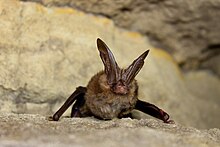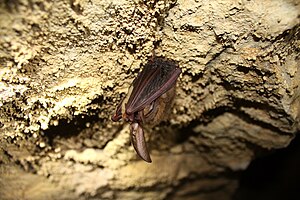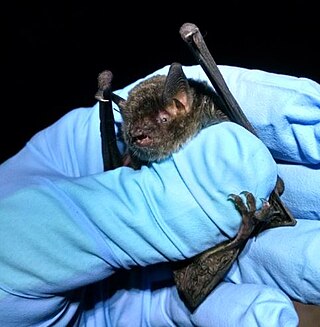
The gray bat is a species of microbat endemic to North America. It once flourished in caves all over the southeastern United States, but due to human disturbance, gray bat populations declined severely during the early and mid portion of the 20th century. 95% of gray bats now hibernate in only 15 caves. M. grisescens has been listed as federally endangered by the U.S. Fish and Wildlife Service since 1976, and is protected under the Endangered Species Act. Gray bat populations were estimated at approximately 2 million bats around the time they were placed on the Endangered Species list. By the early 1980s populations of gray bats dropped to 1.6 million. With conservation efforts in place, in 2004, gray bat populations were estimated to have reached 3.4 million.

The greater horseshoe bat is an insectivorous bat of the genus Rhinolophus. Its distribution covers Europe, Northern Africa, Central Asia and Eastern Asia. It is the largest of the horseshoe bats in Europe and is thus easily distinguished from other species. The species is sedentary, typically travelling up to 30 kilometres (19 mi) between the winter and summer roosts, with the longest recorded movement being 180 km (110 mi). The frequencies used by this bat species for echolocation lie between 69–83 kHz, have most energy at 81 kHz and have an average duration of 37.4 ms.
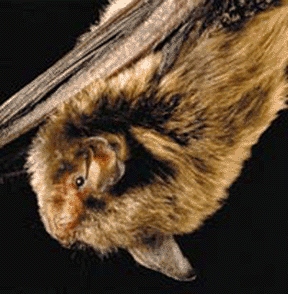
The Indiana bat is a medium-sized mouse-eared bat native to North America. It lives primarily in Southern and Midwestern U.S. states and is listed as an endangered species. The Indiana bat is grey, black, or chestnut in color and is 1.2–2.0 in long and weighs 4.5–9.5 g (0.16–0.34 oz). It is similar in appearance to the more common little brown bat, but is distinguished by its feet size, toe hair length, pink lips, and a keel on the calcar.

The southeastern myotis is a small bat found throughout the Gulf Coastal Plain and the Lower Mississippi Alluvial Plain of the southeastern United States.

The genus Corynorhinus consists of the big-eared bats, or American long-eared bats. Only three species occur in the genus, all occurring in North America. Members of this group were previously in the genus Plecotus, the long-eared bats, and were also then called lump-nosed bats. Populations of these species are generally uncommon and declining. Two subspecies, the Virginia big-eared bat and the Ozark big-eared bat are federally endangered.

Hellhole is a large and deep pit cave in Germany Valley of eastern West Virginia. It is the seventh longest cave in the United States and is home to almost half of the world's population of Virginia big-eared bats. At 737 feet (225 m), Hellhole is the deepest of several caves in the Valley.

The Mexican big-eared bat is a species of vesper bat endemic to Mexico. They are nocturnal and insectivorous. Their very large ears are located across their foreheads, and when captured, the bats are observed to curl their ears in a protective manner. The adults are usually brown colored, while the juveniles are usually a smokey brown color. They have small noses.

Rafinesque's big-eared bat, sometimes known as the southeastern big-eared bat, is a species of vesper bat native to the southeastern United States.

Townsend's big-eared bat is a species of vesper bat.

Bechstein's bat is a species of vesper bat found in Europe and western Asia, living in extensive areas of woodland.

The eastern small-footed bat is a species of vesper bat. It can be found in southern Ontario and Quebec in Canada and in mountainous portions of the eastern United States from New England to northern Georgia, and westward to northern Arkansas. It is among the smallest bats in eastern North America and is known for its small feet and black face-mask. Until recently, all North American small-footed Myotis were considered to be "Myotis leibii". The western population is now considered to be a separate species, Myotis ciliolabrum. The Eastern small-footed bat is rare throughout its range, although the species may be locally abundant where suitable habitat exists. Studies suggest white-nose syndrome has caused declines in their populations. However, most occurrences of this species have only been counted within the past decade or two and are not revisited regularly, making their population status difficult to assess. Additionally, most bat populations in the Eastern U.S. have been monitored using surveys conducted in caves and mines in the winter, but Eastern small-footed bats hibernate in places that make them unlikely to be encountered during these surveys. Perhaps as a result, the numbers of Eastern small-footed bats counted in winter tend to be low and they are relatively variable compared to other species of bats. Many biologists believe the species is stable, having declined little in recent times, but that it is vulnerable due to its relatively restricted geographic range and habitat needs.

The fringed myotis is a species of vesper bat that is found in British Columbia, Mexico, and the western United States.
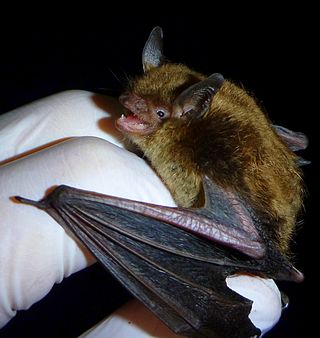
The little brown bat or little brown myotis is an endangered species of mouse-eared microbat found in North America. It has a small body size and glossy brown fur. It is similar in appearance to several other mouse-eared bats, including the Indiana bat, northern long-eared bat, and Arizona myotis, to which it is closely related. Despite its name, the little brown bat is not closely related to the big brown bat, which belongs to a different genus.
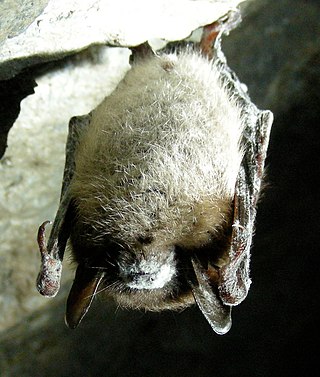
White-nose syndrome (WNS) is a fungal disease in North American bats which has resulted in the dramatic decrease of the bat population in the United States and Canada, reportedly killing millions as of 2018. The condition is named for a distinctive fungal growth around the muzzles and on the wings of hibernating bats. It was first identified from a February 2006 photo taken in a cave located in Schoharie County, New York. The syndrome has rapidly spread since then. In early 2018, it was identified in 33 U.S. states and seven Canadian provinces; plus the fungus, albeit sans syndrome, had been found in three additional states. Most cases are in the eastern half of both countries, but in March 2016, it was confirmed in a little brown bat in Washington state. In 2019, evidence of the fungus was detected in California for the first time, although no affected bats were found.

Climate change in West Virginia is an ongoing concern. Most of the state has warmed one-half to one degree Fahrenheit (0.28–0.56 °C) in the last century, and heavy rainstorms are becoming more frequent. In the coming decades, a changing climate is likely to increase flooding, harm ecosystems, increase some health problems, and possibly threaten some recreational activities. The average temperature in Charleston, West Virginia, has increased 1.1 °F (0.61 °C) over the last century, and precipitation has increased by up to 10% in many parts of the state.

The Ozark big-eared bat is an endangered species found only in a small number of caves in Arkansas, Oklahoma and Missouri, the southern central United States. Also known as the western big-eared bat, the long-eared bat, and the lump-nosed bat, its appearance is defined by a pair of outsize ears and a lump-adorned nose. The Ozark big-eared bat is the largest and reddest of the five subspecies of Corynorhinus townsendii and is medium-sized and weighs from 0.2 to 0.5 ounces. It has very large, 1-inch-long ears that connect at the base across the forehead. The snout has large, prominent lumps above the nostrils. These particular bats feed on moths and other insects; they forage along forest edges.

Originally known as the Oklahoma Bat Caves National Wildlife Refuge, Ozark Plateau National Wildlife Refuge was established for the protection of endangered bats and their habitat. The refuge is made up of several parcels of land located in northeastern Oklahoma. These parcels contain numerous caves considered crucial for the bats' survival.

Myotis septentrionalis, known as the northern long-eared bat or northern myotis, is a species of bat native to North America. There are no recognized subspecies. The northern long-eared bat is about 3–3.7 inches in length, with a wingspan of 9–10 inches. It is distinguishable by its long ears when comparing it to other bats in its genus. This species is commonly found in the northern United States and Southern Canada east of British Columbia. The geographic range includes 37 states.
There are eighteen indigenous species of bats in Canada, which are found in many parts of the country. They are insectivores, and are prey to falcons, hawks, owls, snakes, cats, and raccoons.

A maternity colony refers to a temporary association of reproductive female bats for giving birth to, nursing, and weaning their pups. The colonies are initiated by pregnant bats. After giving birth, the colony consists of the lactating females and their offspring. After weaning, juveniles will leave the maternity colony, and the colony itself will break apart. The size of a maternity colony is highly variable by species, with some species forming colonies consisting of ten or fewer individuals, while the largest maternity colony in the world in Bracken Cave is estimated to have over 15 million bats.
